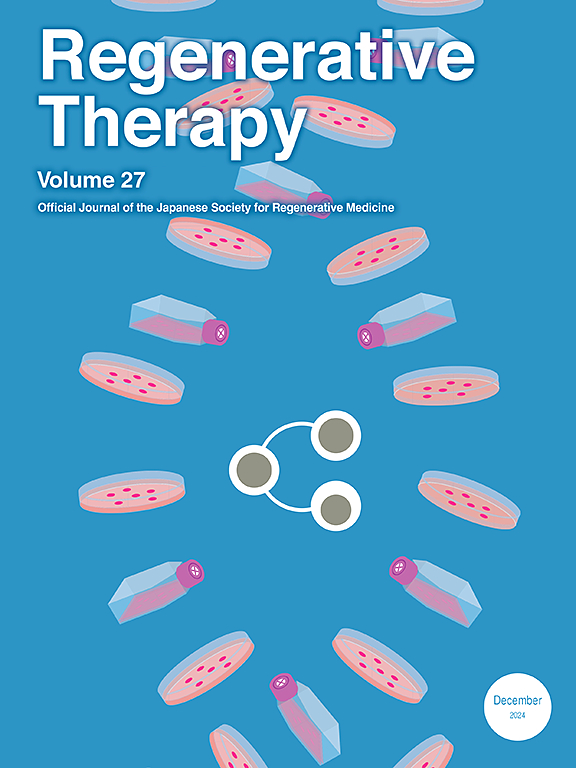Polydactyly bone marrow-derived mesenchymal stem cell-conditioned medium can prevent cartilage degeneration and alleviate knee pain in a rat model of osteoarthritis
IF 3.5
3区 环境科学与生态学
Q3 CELL & TISSUE ENGINEERING
引用次数: 0
Abstract
Background
Osteoarthritis (OA) is characterized by progressive degeneration of joint cartilage and has substantially increased worldwide. Recently, Mesenchymal stem cells (MSCs) have been explored as a cell-based therapy for the treatment of OA. MSC therapy has not been safely introduced into clinical practice due to immune rejection and the need for highly controlled culture protocols. The therapeutic efficacy of MSC treatment is mediated by the paracrine effect, and conditioned medium (CM) containing MSC-derived secreted factors have potential for useful cell-free therapy. CM can be prepared from various sources, though bone marrow MSCs obtained from infant polydactyly patients may be particularly useful for chondrogenic differentiation and the regulation of cartilage formation. The purpose of this study was to evaluate the effect of polydactyly bone marrow MSC-derived conditioned medium (pBMSC-CM) on the prevention of cartilage degeneration and knee pain using a rat monoiodoacetate (MIA)-induced knee OA model.
Methods
pBMSC-CM was isolated from the bone marrow of an infant polydactyly thumb. In vitro, cell proliferation was evaluated in chondrocytes cultured with pBMSC-CM, and gene expression of cartilage matrix markers was assessed by quantitative reverse transcription PCR. RNA sequencing was conducted to analyze differentially expressed genes in pBMSCs. A knee arthritis model was generated by an intra-articular injection of MIA into the right knee of 18 Sprague-Dawley rats, which were then divided into three groups: (1) No-treatment group, (2) Culture medium only group, and (3) pBMSC-CM group. Each group received intra-articular injections of either saline, alpha-Minimal Essential Medium, or pBMSC-CM one week after the MIA injection. To assess knee joint pain, the struggle threshold of the knee joint extension angle was measured every week. Two weeks after treatment injections, a retrograde neurotracer was injected into both knees. After one week, articular cartilage and synovitis were evaluated based on histological characteristics. The dorsal root ganglions (DRG) were immunostained to evaluate the expression of calcitonin gene-related peptide (CGRP).
Results
pBMSC-CM enhanced chondrocyte proliferation and upregulated cartilage matrix genes. Chondrogenic and neuroprotective genes were highly expressed in pBMSCs. In behavioral tests, the pBMSC-CM group showed significant improvement in struggle threshold compared to the no-treatment and culture medium only groups. Histological evaluation showed significantly less cartilage degeneration in the pBMSC-CM group than in the other two groups. There were no significant differences in the degree of synovitis among the three groups, although CGRP expression in DRG was lower in the pBMSC-CM group.
Conclusion
In this study, pBMSC-CM therapy reduced extracellular matrix degeneration in the articular cartilage and suppressed CGRP expression in the DRG in an MIA-induced rat OA model. Our findings suggest that pBMSC-CM therapy alleviated knee pain not only in the behavioral test but also in CGRP assessment. Overall, this study provides important insights into the potential of pBMSC-CM for the treatment of knee OA and contributes to future clinical trials.
多趾骨髓间充质干细胞条件培养基可预防骨关节炎模型大鼠软骨变性和减轻膝关节疼痛
骨关节炎(OA)以关节软骨进行性退行性变为特征,在世界范围内已显著增加。最近,间充质干细胞(MSCs)已被探索作为一种基于细胞的治疗OA的方法。由于免疫排斥和需要高度控制的培养方案,MSC治疗尚未安全地引入临床实践。间充质干细胞治疗的治疗效果是由旁分泌作用介导的,含有间充质干细胞衍生的分泌因子的条件培养基(CM)具有有用的无细胞治疗的潜力。CM可以从各种来源制备,尽管从婴儿多指畸形患者获得的骨髓间充质干细胞可能对软骨分化和软骨形成的调节特别有用。本研究的目的是利用单碘乙酸(MIA)诱导的大鼠膝关节OA模型,评估多趾髓间充质干细胞衍生条件培养基(pBMSC-CM)对软骨退变和膝关节疼痛的预防作用。方法从婴儿多指拇指骨髓中分离spbmsc - cm。体外用pBMSC-CM培养软骨细胞,观察细胞增殖情况,定量反转录PCR检测软骨基质标志物的基因表达。通过RNA测序分析pBMSCs中差异表达基因。将18只Sprague-Dawley大鼠右膝关节内注射MIA制备膝关节关节炎模型,将大鼠分为3组:(1)不给药组,(2)只给培养基组,(3)pBMSC-CM组。每组在MIA注射一周后接受生理盐水、α - minimal Essential Medium或pBMSC-CM关节内注射。为了评估膝关节疼痛,每周测量膝关节伸角挣扎阈值。注射治疗两周后,双膝注射逆行神经示踪剂。一周后,根据组织学特征评估关节软骨和滑膜炎。免疫染色观察大鼠背根神经节(DRG)降钙素基因相关肽(CGRP)的表达。结果spbmsc - cm可促进软骨细胞增殖,上调软骨基质基因。成软骨基因和神经保护基因在pBMSCs中高度表达。在行为测试中,pBMSC-CM组与未治疗组和仅培养基组相比,挣扎阈值有显著改善。组织学评估显示,pBMSC-CM组软骨退变明显少于其他两组。三组间滑膜炎程度无显著差异,但pBMSC-CM组DRG中CGRP表达较低。结论在本研究中,pBMSC-CM治疗可减轻mia诱导的OA大鼠关节软骨细胞外基质变性,抑制DRG中CGRP的表达。我们的研究结果表明,pBMSC-CM治疗不仅在行为测试中减轻了膝关节疼痛,而且在CGRP评估中也减轻了膝关节疼痛。总的来说,这项研究为pBMSC-CM治疗膝关节OA的潜力提供了重要的见解,并有助于未来的临床试验。
本文章由计算机程序翻译,如有差异,请以英文原文为准。
求助全文
约1分钟内获得全文
求助全文
来源期刊

Regenerative Therapy
Engineering-Biomedical Engineering
CiteScore
6.00
自引率
2.30%
发文量
106
审稿时长
49 days
期刊介绍:
Regenerative Therapy is the official peer-reviewed online journal of the Japanese Society for Regenerative Medicine.
Regenerative Therapy is a multidisciplinary journal that publishes original articles and reviews of basic research, clinical translation, industrial development, and regulatory issues focusing on stem cell biology, tissue engineering, and regenerative medicine.
 求助内容:
求助内容: 应助结果提醒方式:
应助结果提醒方式:


